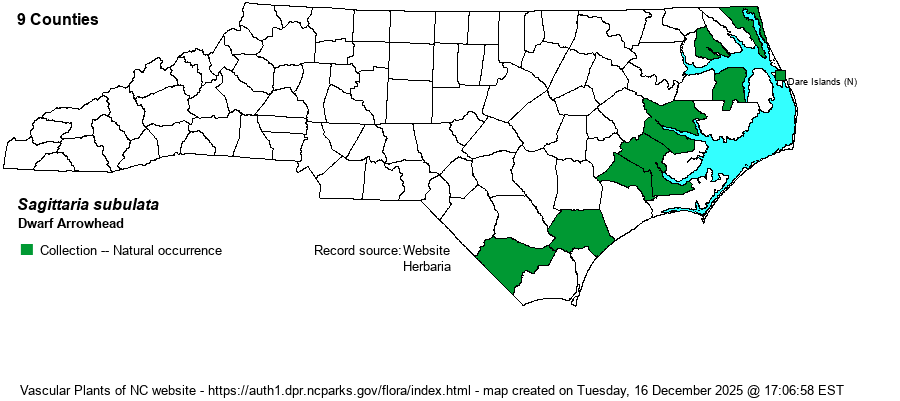| Author | (L.) Buchenau | |
| Distribution | Found essentially only in coastal areas and the Tidewater zone, from Currituck County on the north to Columbus County on the south.
This is a coastal and near-coastal species of the Atlantic Coast region, ranging north to MA and south to FL and west to AL. | |
| Abundance | Rare to uncommon in the Tidewater region. The NCNHP changed the State Rank from S2S3 to S2 in 2024 and placed the species on the Watch List. | |
| Habitat | This is a species generally of tidal freshwater or oligohaline marshes, but especially on exposed mudflats and drawdown areas. It also can be found along margins of natural lakes and ponds, generally ones rather close to the coast. | |
| Phenology | Blooms from May to September, and fruits shortly after flowering. | |
| Identification | This is one of several confusing species that has both submerged leaf forms and emergent ones. Where leaves are submerged, they are phyllodial and can be up to 1.5 feet long, and very narrow (barely 1/5-inch wide). However, emergent leaves are much shorter, often just 2-3 inches long, though still mostly with linear (and flat) leaves. Occasionally, floating leaves can have ovate/elliptical leaves! The flowering scape can be up to 1 feet high, generally far overtopping the leaves. The flowers are in 1-3 whorls, but in this species each flower is on a long and slender pedicel (1 inch or more), and thus the flowers are a far way from the stem. Each flower, consisting of 3 white petals, is only 1/2-inch across or less. The most similar species is the odd S. filiformis, which usually has submerged stems that are 10 inches to up to 3 feet long. As with so many species of Sagittaria, if not seen in flower, most biologists will overlook it as a short grass or sedge. | |
| Taxonomic Comments | Though this has always been a good species, some references have or had one or more other taxa within it. RAB (1968) named this taxon as S. subulata var. subulata, and also S. subulata var. gracillima (now named as S. filiformis). Weakley (2018) has S. filiformis as a good species, as do many other references.
| |
| Other Common Name(s) | Awl-leaf Arrowhead, Narrow-leaved Arrowhead, Dwarf Sagittaria | |
| State Rank | S2 | |
| Global Rank | G4 | |
| State Status | W1 | |
| US Status | | |
| USACE-agcp | OBL link |
| USACE-emp | OBL link |

